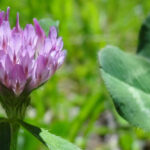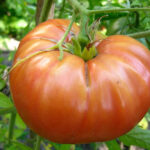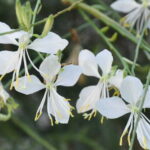An insecticide that will be in a lot of gardeners’ sheds is pyrethrin spray. Pyrethrin can be controversial among gardeners because although it’s naturally derived, it can harm beneficial insects as well as humans in large amounts. There’s also a synthetic version called permethrin that can make the topic a little confusing. Some gardeners think it’s best to stay away from all of it, just to be safe.
But at the same time, pyrethrins will make your life a lot easier when it comes to pest control, especially when you’re dealing with major outbreaks that you need to control fast. It can kill sucking insects like mosquitoes and aphids and flying insects like whiteflies. Not to mention it also kills stink bugs, ants, and even fleas!
Even though pyrethrins can cause problems, many brands are OMRI-rated as safe for organic gardening use, so you can use them if you prefer to omit synthetic chemicals from your garden. And while permethrins aren’t organic, you can still use them in the garden, and they can also be found in treated clothing and flea collars to ward off pests while they’re worn.
We’ll get into the good and the bad of pyrethrins and permethrins and everything that makes them similar and different.
What Is Pyrethrin Spray?
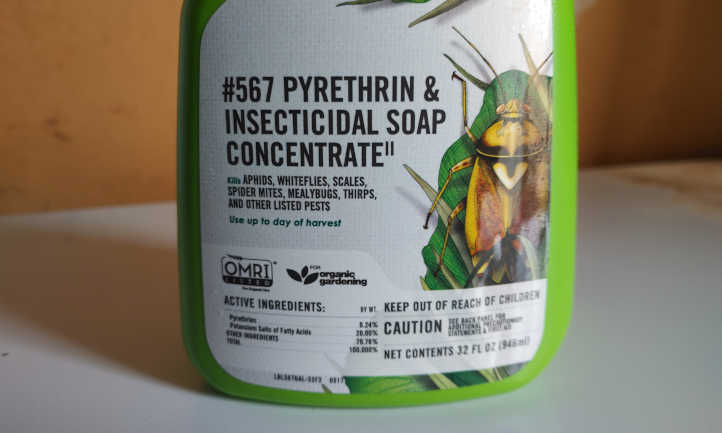
Pyrethrin is made of six naturally-occuring toxins that can be found in the dried flower heads of a certain chrysanthemum flower, Chrysanthemum cinerariifolium. Synonyms for its botanical name are Tanacetum cinerariifolium or Pyrethrum cinerariifolium. You may have heard this species of chrysanthemum flowers referred to as the painted daisy or pyrethrum daisy because of this use. The toxins are extracted from the flowers, diluted, and used as an insecticide.
Pyrethrin, sometimes called pyrethrum, was first registered as a pesticide in the 1950s. It has been used to kill fleas, flies, ants, moths, mosquitoes, and many other pests. If only natural ingredients are mixed into pyrethrin sprays, the products are generally recognized as safe for organic gardening by the Organic Materials Review Institute, or OMRI.
Similar to pyrethrin is permethrin. Permethrin is lab-synthesized, but it acts just like the toxins that are found in chrysanthemum flowers. They’re used similarly to pyrethrins but are more frequently used for insect pests in buildings, clothing, and on pets and livestock.
Permethrin was registered with the U.S. Environmental Protection Agency (EPA) in 1979, and later was brought under review due to safety concerns, but was once again deemed safe and registered again in 2006.
How Do Pyrethrins Work?
Pyrethrins and permethrin kill insect pests in a similar way. Each of them excites the insect’s nervous system once the insect touches or eats the insecticide. They eventually become paralyzed and die because their bodies can’t get rid of the toxins quickly enough.
The pyrethrin toxin is usually enough to kill pests, but many products use another chemical or addition, called a synergist, to make it more potent and effective. The added materials used will vary between products. Organic options include insecticidal soaps, neem oil, or similar organic options. If an additional chemical is used, then the product won’t be OMRI-rated as organic even if the natural pyrethrin is used. Check for the OMRI rating on your pyrethrin if you’re doing organic gardening, just to be sure it’s an appropriate pesticide for your needs.
Small amounts of pyrethroids won’t hurt humans or animals because their bodies are capable of breaking down the toxins. However, other mammals have slightly higher sensitivities than humans do, especially when it comes to permethrins. If you have pets, take note that cats are usually more sensitive than dogs. Because a pyrethroid kills insects, however, these are often used for pest control collars such as flea collars.
Types Of Pyrethroids
You’ll most likely find pyrethrin and permethrin in the form of a ready-to-use spray (RTU) or a concentrate that will need to be mixed with water before you use it. Both kinds can be sprayed directly on plants as needed. These two pesticides can also come in the form of foggers, dusts or pyrethrum powder, pet shampoo, and head lice products.
Permethrin is a bit more flexible in its uses. You can find this product in insect repellent, flea collars and medication, treated clothing, and cattle ear tags. It’s commonly used in public health mosquito control programs and is sprayed over large areas to combat large infestations.
Remember that pyrethrin is naturally-derived from chrysanthemums and can be used in organic gardening, and that permethrin is synthetic but works the same way as pyrethrin.
Other Pyrethroids
There are other types of lab-derived pyrethrin-like products such as bifenthrin, deltamethrin, and resmethrin. These chemicals aren’t as closely related to pyrethrin, but they’re still in the pyrethroid family.
You likely won’t use these in the garden, but you may still want to know what they’re used for. Bifenthrin is typically used in conventional farming and is available as sprays, granules, or aerosols. Deltamethrin is typically used outdoors in large areas such as golf courses, but they can also be used indoors in cracks where pests enter the building. Resmethrin is used in food-handling facilities, industrial facilities, or for livestock and pets to control insects such as fleas or flies.
Many other pyrethroids are available, but these typically aren’t available to residential gardeners and are limited to commercial use. Some pyrethroids have been banned due to their potential to harm people and the environment.
Benefits Of Using Pyrethrin
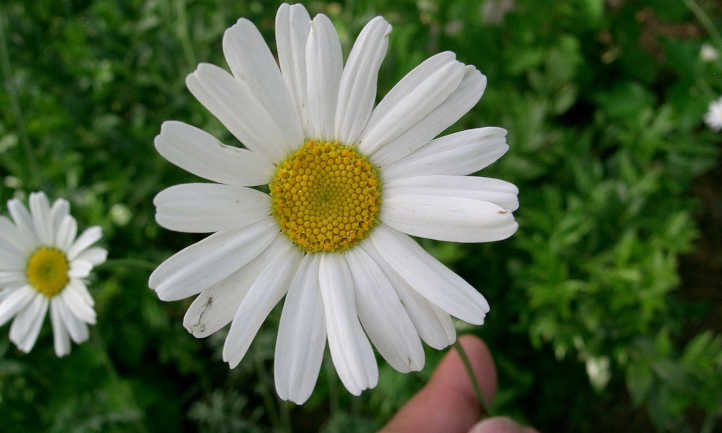
Pyrethrin is highly effective against most insects, making it a favorite choice of many gardeners. It can control aphids, cabbage loopers, fleas, flea beetles, leafhoppers, stink bugs, moths, mosquitoes, and ants. Since it’s a natural insecticide, you can use it in the garden around flowers, vegetables, fruits, and other plants. There are a few precautions you’ll need to take, but we’ll get into that in the next section.
The lab-derived permethrin can be integrated into specially treated clothing and accessories to keep mosquitoes, fleas, and other bugs away while you wear them. These products are great to take on camping trips or out to the lake. Flea collars will keep your pets bug-free and will prevent your home from being infested. Permethrin is also available for garden use as a pesticide, although it’s generally in combination with other insecticides in sprays and is just one of the active ingredients.
Both insecticides are powerful forms of insect control, and you don’t even have to use large amounts to make it work. Spraying just a little insecticide where you need it will be enough to control the outbreak but it won’t be enough to harm you or your loved ones.
Pyrethrin sprays are popular in the garden, but there are many other forms that are typically used indoors to combat fleas and other insects. Foggers are potent and will kill pests instantly while dusts work slower but provide a more long-term solution.
Drawbacks Of Using Pyrethrin
Pyrethrin insecticide does have its concerns you should take into consideration before you use it, as does permethrin. The biggest concern to note is that it’s highly toxic to bees and other beneficial insects. The concern is mostly when the spray is wet. Once it dries and begins to break down in the environment, it becomes less of a concern.
The best way to avoid harming friendly critters is to apply the spray early in the morning so it will have time to dry before they come out to pollinate. When you spray, aim for the leaves and stems and avoid the flowers unless they’re actively infested by pests. Alternately, wait until just before sunset and spray your plants then, as most bees will have retreated to their hives for the night by that point.
Another drawback is that small amounts of pyrethrins are irritating to humans and animals, and large amounts can be harmful. If it comes into contact with the skin, eyes, or mouth, or is inhaled, it can cause several symptoms, including burning and irritation, runny nose, coughing, difficulty breathing, vomiting, and asthma-like symptoms. If you come into contact with a small amount, you likely won’t get more than irritation and burning. Still, you should always wear protective gear and keep children and pets away from it at all times.
Pyrethrins are also highly toxic to a variety of aquatic animals, such as lobster, oysters, shrimp, fish, and insects. According to the National Pesticide Information Center, studies have shown that minnows exposed to pyrethrins laid fewer eggs over time. Fortunately, the toxins usually break down in the soil before they’re able to reach the groundwater, making them not much of a threat to aquatic life if you’re only using them in the garden.
How To Use Pyrethrin Insecticides
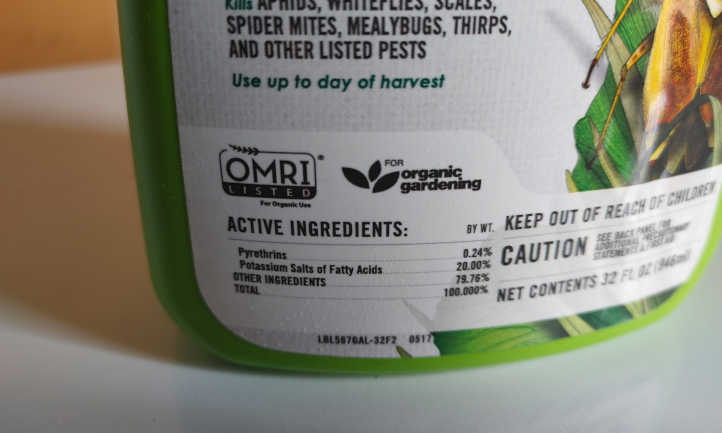
Carefully follow the label instructions since each brand will probably have its own directions for the product.
You’ll find pyrethrin spray in the form of a concentrated solution that needs to be mixed before you use it or as a pre-mixed ready-to-use (RTU) spray with a hand sprayer. Concentrates will require a small portion, usually up to a few tablespoons, to be mixed with water. Some products will require you to add neem oil or soap to the mixture. Some RTUs may have neem oil or soap in the mix already.
Once you’ve mixed up the concentrate according to the label instructions or removed the packaging from your RTU spray, you can spray the mix directly onto the infested plants. Try to avoid flower heads and buds so you won’t risk bees and other pollinators coming into contact with the spray since it’s toxic to them.
Although this step isn’t required, you can cover the plants with a row cover until the spray dries to protect pollinators. The spray becomes less of a threat once it’s dry, so you can remove the cover at that point.
Another way to protect pollinators is to selectively spray the areas that need attention rather than spraying the entire plant or bed. If you notice a few specific plants or one particular bed that has a pest problem, try only spraying those plants first before you spray your entire garden. You’ll be able to minimize the risk to not only the bees but to yourself and others that may be in the area.
When you spray your garden, wear protective clothing and gear, so you don’t come into contact with it, even if you’re using an organic form of pyrethrin insecticide. Eye goggles, face masks, and long sleeves will prevent you from accidentally inhaling or coming into contact with the spray. This is an especially important step if you use foggers or dusts since those can make their way into your eyes or nose more easily than sprays can.
Pyrethrin sprays can be used all on fruits and vegetables up to a few days before harvest. When exposed to sunlight, the National Pesticide Information Center reports that pyrethrins will break down within a matter of a few days, making them safe for edible garden use. Of course, follow the label directions on your bottle; the label directions will indicate the ideal amount of time to wait before harvesting. They’re also effective on ornamental plants.
Frequently Asked Questions
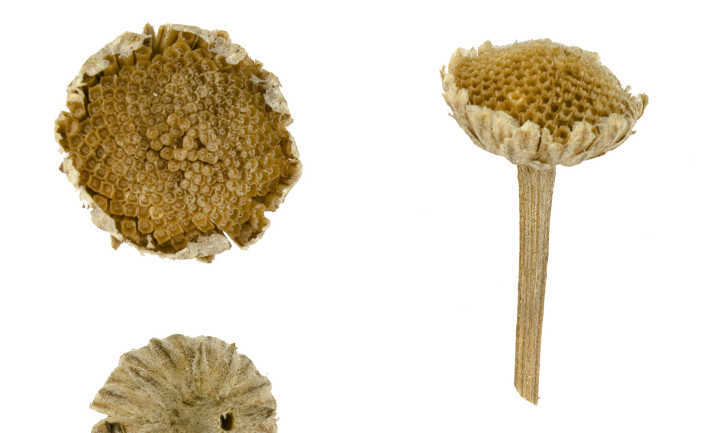
Q: Is pyrethrin harmful to humans?
A: Pyrethrin insecticide is harmful to humans in large amounts. Small amounts may cause irritation, whether it’s burning sensations or breathing difficulties. It’s important to make sure you’re properly protected when handling pyrethrins so you aren’t accidentally exposed. The small amounts you’ll put on your plants won’t be enough to hurt you as long as you prevent yourself from being directly exposed. Most mammals won’t be harmed by the small doses used for typical pest control applications.
Q: What does pyrethrin kill?
A: Pyrethrins will kill almost any insect! Ants, many flying insects, mosquitoes, moths, leafhoppers, and aphids are just a few of the many pests it will kill when they’re exposed. The downside to this is that it can kill beneficial pollinators that every garden needs, including bees. Avoid spraying pyrethrins on flowers and buds, and avoid spraying during the time of day that these insects are out. Early morning applications or just before sundown are the safest times of day to apply to your plant.
Q: Is pyrethrin banned?
A: Pyrethrin is not banned, but some forms of pyrethroids are. Pyrethroids are synthetic, man-made versions of pyrethrin that behave in similar manners to the natural pyrethrin that comes from chrysanthemum flowers. When the risks of pyrethroids were being reassessed, some of them were banned due to risk concerns. Both pyrethrins and permethrins are considered safe for most garden use, and those are the ones you’ll likely find for retail sale.


